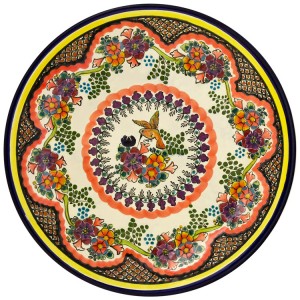 Talavera is a unique type of pottery that comes from Puebla in Mexico. Although the natives of the area had been making pottery for a long time, when the Spanish arrived in the 16th century, they taught the locals new techniques. Using the Spaniards’ tin-based glaze and pottery wheel, the locals began producing this unique type of pottery. Talavera is highly sought after, and if you want to purchase authentic pieces, there are a few things you should know. By doing research on how to identify Talavera, the types of pottery, and how to authenticate them, as well as following a few helpful guidelines, finding authentic pieces is easy.
Talavera is a unique type of pottery that comes from Puebla in Mexico. Although the natives of the area had been making pottery for a long time, when the Spanish arrived in the 16th century, they taught the locals new techniques. Using the Spaniards’ tin-based glaze and pottery wheel, the locals began producing this unique type of pottery. Talavera is highly sought after, and if you want to purchase authentic pieces, there are a few things you should know. By doing research on how to identify Talavera, the types of pottery, and how to authenticate them, as well as following a few helpful guidelines, finding authentic pieces is easy.
Talavera pottery pieces have a distinct, milky-white finish and a raised design. Collectors consider a piece to be authentic Talavera if it comes from the city of Puebla, or nearby places such as Cholula, Atlixco, and Tecali, not only because of the techniques the artisans use, but also because of the natural clay found in these areas. To make Talavera, potters use two kinds of clay: dark clay and light red clay. They mix the two clays together, then knead them, and then strain them. Some artists use a wheel to make bowls and vases, or they hand press and shape them around a mold. They leave the pieces to dry for two to three months, and then the pieces go through a first firing, before undergoing a glazing process. They add designs using stencils and hand painting, before firing them once again, this time at a higher temperature.
Talavera is quite versatile, and artists make a variety of items, not just bowls and vases, from this type of earthenware. Many come in the traditional designs and make for great decorative and utilitarian pieces in the home.
While there are many types of individual pottery pieces, clay tiles are the most popular application for Talavera. Many buildings in Mexico City and Puebla use these tiles for decoration. Talavera clay tiles are also a distinct feature in traditional Puebla kitchens, used as decoration for walls, counters, and food containers.
One thing anyone who wants to buy Talavera should know is how to spot authentic pieces and distinguish them from regular types of pottery. The Mexican Government, through the Mexican Talavera Regulatory Council, has actually laid down some rules to limit the production of this type of pottery to within four districts. Any workshop looking to produce authentic Talavera must apply for certification from the council, and must pass a verification process each month.
Real Talavera must pass other standards as well. The workshop making the Talavera pottery must only use the two types of clay that come from the area. Next, the artist must only hand-form the clay. For example, he or she must never mix the clay into a liquid consistency and pour it into molds. The clay should have a tin and lead glaze base, which should be slightly porous and not pure white. Finally, artists must paint the pieces by hand, using only the prescribed colors: blue, green, yellow, red, brown, and black, although mixing these colors with blue to form orange and purple is acceptable.
